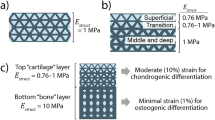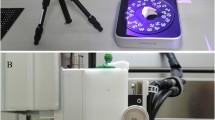Abstract
Tissue engineering is making a progress toward reproduction of original tissue-like constructs to regenerate a damaged tissue. Many studies have been focusing on manufacturing tissue-engineered constructs (TECs), but only few technologies are available to evaluate the conformation and volume of TECs, which critically influences successful implantation of them in vivo. In this study, a laser scan system is developed and applied to measure the volume of irregular objects of engineered cartilages. In the system, the laser beam starts to scan surface of a rotating object at one end, and moves to the other end with a regular interval (Δh) along the rotation axis to repeat the scanning process. Each scanning process yields hypothetical segments of the object and a computer program determines the shape and volume of them to construct 3 dimensional conformations. The total volume of the object is then obtained by summating the volumes of all segments. The accuracy of the laser scan system was verified using three types of regular objects, TECs and irregular objects by comparing the results with those obtained from the geometrical method (absolute value), image-based system and hydrostatic weighing method. The laser scan system showed more than 98% accuracy with less than 1% standard error for all three types of objects, while the imagebased system showed approximately 95∼97% accuracy. These findings suggest that the laser scan system is a very accurate and reproducible tool to evaluate 3D conformation of TECs to be implanted in vivo.
Similar content being viewed by others
Reference
JH Cui, SR Park, K Park, et al., Preconditioning of rabbit mesenchymal stem cells in polyglycolic acid (PGA) scaffold using low-intensity ultrasound improved regeneration of cartilage in rabbit articular cartilage defect model, Tissue Eng Regen Med, 7, 24 (2010).
JG Park, JH Lee, JN Kim, et al., Chondrogenic differentiation of human adipose tissue-derived stem cells in functional PLGA scaffolds, Tissue Eng Regen Med, 8, 47 (2011).
JJ Yoo, HN Kim, EH Bae, et al., Culture of human chondrocytes in a macroporous PLGA scaffold for up to sixteen weeks, Tissue Eng Regen Med, 8, 300 (2011).
P Dastidar, T Heinonen, T Vahvelainen, et al., Computerised volumetric analysis of lesions in multiple sclerosis using new semi-automatic segmentation software, Med Biol Eng Comput, 37, 104 (1999).
S Shiffman, GD Rubin, S Napel, Medical image segmentation using analysis of isolable-contour maps, IEEE Trans Med Imaging, 19,1064 (2000).
L Hangody, P Feczko, L Bartha, et al., Mosaicplasty for the treatment of articular defects of the knee and ankle, Clin Orthop Relat Res, 391, S328 (2001).
L Bartha, A Vajda, Z Duska, et al., Autologous osteochondral mosaicplasty grafting, J Orthop Sports Phys Ther, 36, 739 (2006).
AM Bhosale, JB Richardson, Articular cartilage: structure, injuries and review of management, Br Med Bull, 87, 77 (2008).
RS Tuan, A second-generation autologous chondrocyte implantation approach to the treatment of focal articular cartilage defects, Arthritis Res Ther, 9, 109 (2007).
A Akkouch, Z Zhang, M Rouabhia. A novel collagen/hydroxyapatite/poly (lactide-co-ɛ-caprolactone) biodegradable and bioactive 3D porous scaffold for bone regeneration, J Biomed Mater Res A, 96, 693 (2011).
W Dai, N Kawazoe, X Lin, et al., The influence of structural design of PLGA/collagen hybrid scaffolds in cartilage tissue engineering, Biomaterials, 31, 2141 (2010).
GT Chen, JH Kung, KP Beaudette, Artifacts in computed tomography scanning of moving objects, Semin Radiat Oncol, 14, 19 (2004).
E Odaci, B Sahin, OF Sonmez, et al., Rapid estimation of the vertebral body volume: a combination of the cavalieri principle and computed tomography images, Eur J Radiol, 48, 316 (2003).
KH Choi, BS Yoo, SR Park, et al., Novel imaging analysis system to measure the spatial dimension of engineered tissue construct, Artif Organs, 34, 158 (2010).
AC Da Silveira, JL Daw Jr, B Kusnoto, et al., Craniofacial applications of three-dimensional laser surface scanning, J Craniofac Surg, 14, 449 (2003).
N Mankovich J, D Samson, W Pratt, et al., Surgical planning using three-dimensional imaging and computer modeling, Otolaryngol Clin North Am, 27, 875 (1994).
Y Yang, N Paton, Laser scanning as a tool for assessment of HIV-related facial lipoatrophy: evaluation of accuracy and reproducibility, HIV Med, 6, 321 (2005).
I Wilson, L Snape, R Fright, et al., An investigation of laser scanning techniques for quantifying changes in facial soft-tissue volume, N Z Dent J, 93, 110 (1997).
S Aung, R Ngim, S Lee, Evaluation of the laser scanner as a surface measuring tool and its accuracy compared with direct facial anthropometric measurements, Br J Plast Surg, 48, 551 (1995).
KH Choi, BH Choi, SR Park, et al., The chondrogenic differentiation of mesenchymal stem cells on an extracellular matrix scaffold derived from porcine chondrocytes, Biomaterials, 31, 5355 (2010).
K Chang, Y Lee, Hydrostatic weighing at KRISS, Metrologia, 41, S95 (2004).
CH Kau, S Richmond, AI Zhurov, et al., Reliability of measuring facial morphology with a 3-dimensional laser scanning system, Am J Orthod Dentofacial Orthop, 128, 424 (2005).
HY Feng, Y Liu, F Xi, Analysis of digitizing errors of a laser scanning system, Precision Engineering, 25, 185 (2001).
CA McGibbon, J Bencardino, ED Yeh, et al., Accuracy of cartilage and subchondral bone spatial thickness distribution from MRI, J Magn Reson Imaging, 17, 703 (2003).
A Wyler, V Bousson, C Bergot, et al., Hyaline cartilage yhickness in radiographically normal cadaveric hips: comparison of spiral CT arthrographic and macroscopic measurements1, Radiology, 242, 441 (2007).
J Yao, B Seedhom, Ultrasonic measurement of the thickness of human articular cartilage in situ, Rheumatology, 38, 1269 (1999).
Author information
Authors and Affiliations
Corresponding author
Additional information
These authors contributed equally to this work.
Rights and permissions
About this article
Cite this article
Choi, KH., Song, B.R., Yoo, BS. et al. A laser scan-based system to measure three dimensional conformation and volume of tissue-engineered constructs. Tissue Eng Regen Med 10, 371–379 (2013). https://doi.org/10.1007/s13770-013-1099-4
Received:
Revised:
Accepted:
Published:
Issue Date:
DOI: https://doi.org/10.1007/s13770-013-1099-4




